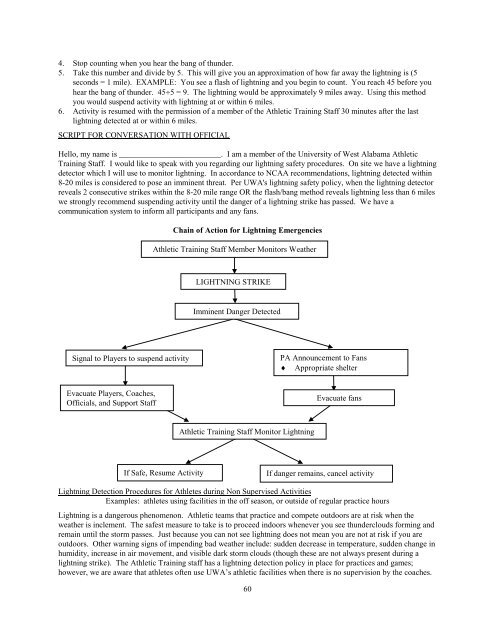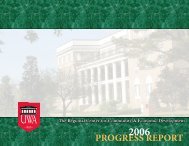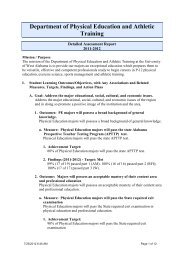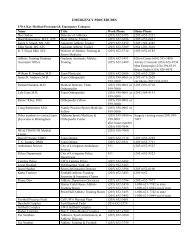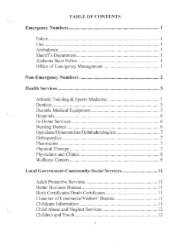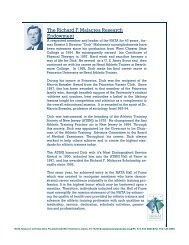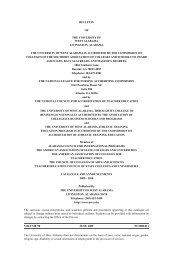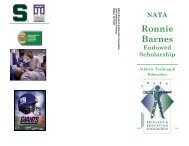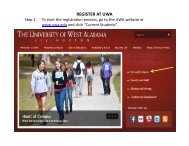table of contents - UWA Athletic Training & Sports Medicine Center
table of contents - UWA Athletic Training & Sports Medicine Center
table of contents - UWA Athletic Training & Sports Medicine Center
You also want an ePaper? Increase the reach of your titles
YUMPU automatically turns print PDFs into web optimized ePapers that Google loves.
4. Stop counting when you hear the bang <strong>of</strong> thunder.5. Take this number and divide by 5. This will give you an approximation <strong>of</strong> how far away the lightning is (5seconds = 1 mile). EXAMPLE: You see a flash <strong>of</strong> lightning and you begin to count. You reach 45 before youhear the bang <strong>of</strong> thunder. 45÷5 = 9. The lightning would be approximately 9 miles away. Using this methodyou would suspend activity with lightning at or within 6 miles.6. Activity is resumed with the permission <strong>of</strong> a member <strong>of</strong> the <strong>Athletic</strong> <strong>Training</strong> Staff 30 minutes after the lastlightning detected at or within 6 miles.SCRIPT FOR CONVERSATION WITH OFFICIALHello, my name is _________________________. I am a member <strong>of</strong> the University <strong>of</strong> West Alabama <strong>Athletic</strong><strong>Training</strong> Staff. I would like to speak with you regarding our lightning safety procedures. On site we have a lightningdetector which I will use to monitor lightning. In accordance to NCAA recommendations, lightning detected within8-20 miles is considered to pose an imminent threat. Per <strong>UWA</strong>'s lightning safety policy, when the lightning detectorreveals 2 consecutive strikes within the 8-20 mile range OR the flash/bang method reveals lightning less than 6 mileswe strongly recommend suspending activity until the danger <strong>of</strong> a lightning strike has passed. We have acommunication system to inform all participants and any fans.Chain <strong>of</strong> Action for Lightning Emergencies<strong>Athletic</strong> <strong>Training</strong> Staff Member Monitors WeatherLIGHTNING STRIKEImminent Danger DetectedSignal to Players to suspend activityPA Announcement to Fans♦ Appropriate shelterEvacuate Players, Coaches,Officials, and Support StaffEvacuate fans<strong>Athletic</strong> <strong>Training</strong> Staff Monitor LightningIf Safe, Resume ActivityIf danger remains, cancel activityLightning Detection Procedures for Athletes during Non Supervised ActivitiesExamples: athletes using facilities in the <strong>of</strong>f season, or outside <strong>of</strong> regular practice hoursLightning is a dangerous phenomenon. <strong>Athletic</strong> teams that practice and compete outdoors are at risk when theweather is inclement. The safest measure to take is to proceed indoors whenever you see thunderclouds forming andremain until the storm passes. Just because you can not see lightning does not mean you are not at risk if you areoutdoors. Other warning signs <strong>of</strong> impending bad weather include: sudden decrease in temperature, sudden change inhumidity, increase in air movement, and visible dark storm clouds (though these are not always present during alightning strike). The <strong>Athletic</strong> <strong>Training</strong> staff has a lightning detection policy in place for practices and games;however, we are aware that athletes <strong>of</strong>ten use <strong>UWA</strong>’s athletic facilities when there is no supervision by the coaches.60


